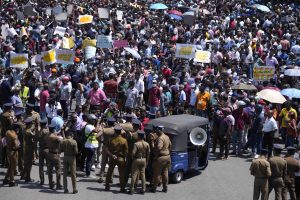Sri Lanka marks 75 years of independence this year. The milestone falls amid an unprecedented economic crisis that has brought with it political, social and economic upheaval. The economic crisis resulted in months-long protests by citizens starting in the spring of 2022. What began as neighborhood protests in different parts of Sri Lanka transformed into an exceptional mobilization of citizens calling for the resignation of the then-President Gotabaya Rajapaksa and his government and a system change.
This mobilization resulted in mass resignations in 2022, resignations that seemed near impossible previously considering the mandates received in 2019 and 2020 by the president and government. But the Rajapaksas were out. Ranil Wickremesinghe was elected as the new president by parliament.
The Wickremesinghe presidency is confronted with multiple challenges, including worrying socioeconomic indexes. It has also been accused of repression, and most recently of delaying local government elections, thereby undermining the right to vote and representative democracy. These have contributed to new levels of frustration and disillusionment among citizens toward the political and bureaucratic elites, with the first three months of 2023 witnessing continued citizen mobilization and agitation.
Sri Lanka has a history of citizen mobilization, largely in response to the cycles of violence, inequalities, and impunity. The present crisis has in effect been brewing for years considering the authoritarian and militarized governance model and ethno-nationalism that has plagued the country for decades. A year after the commencement of what is popularly known as the Aragalaya (meaning “struggle” in Sinhala), questions remain as to the extent of change brought by the people’s mobilization, especially as no genuine efforts have been made to tackle the root causes of the conflict or structure of government, or address the impunity linked to human rights violations and economic crimes.
The deteriorating economic and political crisis in 2022 saw shortages of essential commodities such as food, medicine, cooking gas, and fuel, resulting in long queues for many who struggled to obtain essentials. Such queues also saw people collapse in the heat, with several reported deaths. This period also had power cuts of 12-13 hours a day, impacting all sectors, including different state sectors, hospitals, businesses, and households.
The combination of all these factors shook Sri Lanka to its core, and this in a country that had its share of past cycles of violence and devastation. Despite its past experiences – a near three-decade ethnic conflict, the devastating Easter Sunday attacks in 2019, and numerous cycles of ethno-religious violence – the events of 2022 exposed Sri Lanka’s murky governance system and ill preparedness to handle multiple cascading crises.
Those events exposed Sri Lanka’s crisis in governance, where a powerful executive arm had limited-to-no checks on its decision-making and faced no accountability for its actions or inaction.

































